Daffodil Group Classifications and Flower forms
Daffodils are instantiy recognisable but also surprisingly varied, Experts classify them into 13 Divisions, often referred to in bulb catalogues. The divisions are based primarily on the shape and structure of the flowers, or in some cases the species of Narassusirom which cultivated hybrids are derived, and whose characteristics they have inherited. Species, subspecies, varieties and natural hybrids (those not produced in cultivation, bearing purely botanical names) are all classified in Division 13, however.
Corona refers to the cup or trumpet.
Perianth refers to the petals.
Reflexed petals are those which are angled away from the corona.
Pedicel is the 'neck' of the flower which joins it to the stem.
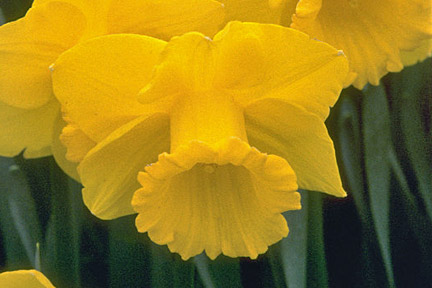 Division 1 – Trumpet: One flower per stem with cups (known as the corona) that are longer than the petals (known as perianth segments). e.g. Narcissus ‘Barnum’
Division 1 – Trumpet: One flower per stem with cups (known as the corona) that are longer than the petals (known as perianth segments). e.g. Narcissus ‘Barnum’ 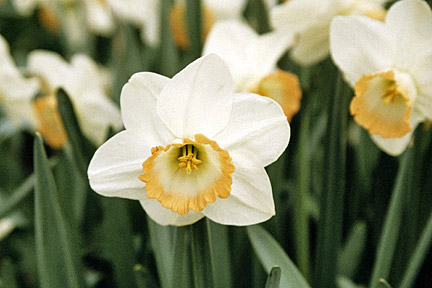 Division 2 – One flower per stem with large cups but the corona is not longer than the perianth segments. e.g. Narcissus ‘Rainbow’
Division 2 – One flower per stem with large cups but the corona is not longer than the perianth segments. e.g. Narcissus ‘Rainbow’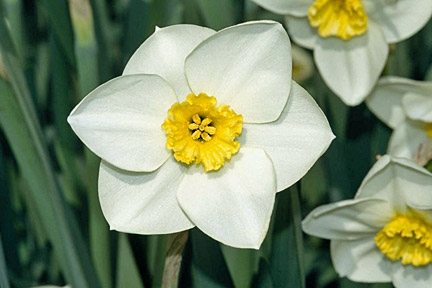 Division 3 – One flower per stem with small cups that are much shorter than the petals. e.g. Narcissus ‘Spindletop’
Division 3 – One flower per stem with small cups that are much shorter than the petals. e.g. Narcissus ‘Spindletop’ 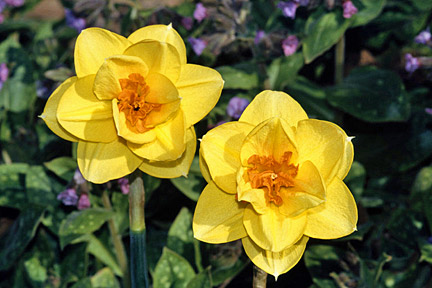 Division 4 – Double: These have double blooms, giving a ruffled appearance without an obvious distinction between cup and petals. e.g. Narcissus ‘Tamar Fire’
Division 4 – Double: These have double blooms, giving a ruffled appearance without an obvious distinction between cup and petals. e.g. Narcissus ‘Tamar Fire’ 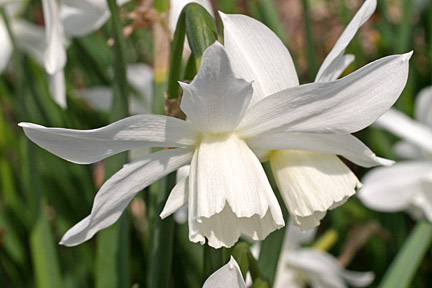 Division 5 – Triandrus: These are small-flowered daffodils with up to five pendent blooms per stem and the perianth segments are often reflexed; they naturalise well in grassy areas. e.g. Narcissus ‘Petrel’
Division 5 – Triandrus: These are small-flowered daffodils with up to five pendent blooms per stem and the perianth segments are often reflexed; they naturalise well in grassy areas. e.g. Narcissus ‘Petrel’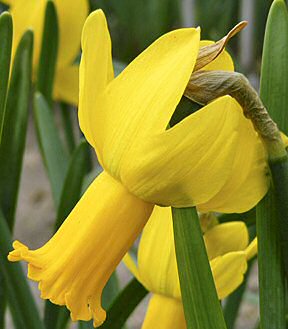 Division 6 – Cyclamineus: One small flower per stem with petals that sweep backwards from the cup (reflexed perianth segments); they flower early and can be naturalised in grass. e.g. Narcissus ‘Warbler’
Division 6 – Cyclamineus: One small flower per stem with petals that sweep backwards from the cup (reflexed perianth segments); they flower early and can be naturalised in grass. e.g. Narcissus ‘Warbler’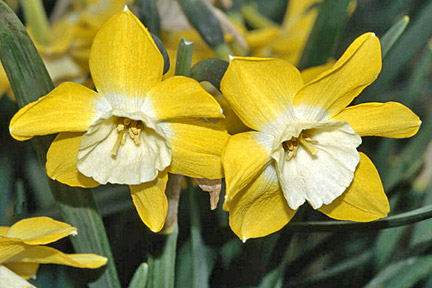 Division 7 – Jonquilla and Apodanthus: These are fragrant, with two to five small flowers per stem., reflexed or spreading. Corona iscup or funnel shaped or flared usually wider than long, e.g. Narcissus ‘Dickcissel’
Division 7 – Jonquilla and Apodanthus: These are fragrant, with two to five small flowers per stem., reflexed or spreading. Corona iscup or funnel shaped or flared usually wider than long, e.g. Narcissus ‘Dickcissel’ 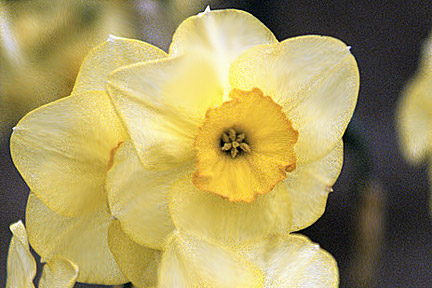 Division 8 – Tazetta: These have up to 20 small flowers per stem with perianth segments spreading (not reflexed). Some are scented and some are only half hardy. e.g. Narcissus ‘Highfield Beauty.
Division 8 – Tazetta: These have up to 20 small flowers per stem with perianth segments spreading (not reflexed). Some are scented and some are only half hardy. e.g. Narcissus ‘Highfield Beauty.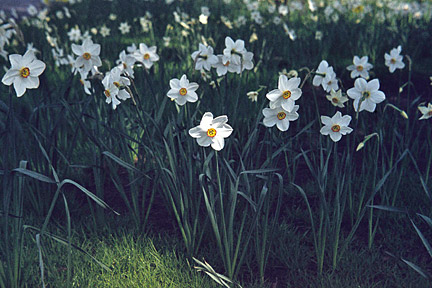 Division 9 – Poeticus: These have small cups in contrasting colours to the large white petals. They can be naturalised in grass. e.g. Narcissus ‘Actaea’
Division 9 – Poeticus: These have small cups in contrasting colours to the large white petals. They can be naturalised in grass. e.g. Narcissus ‘Actaea’ 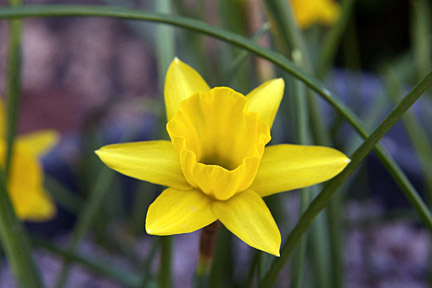 Division 10 – Bulbocodium: These are short, with delicate, rush-like leaves; the cups are much larger than the petals; they flower early and naturalise well in grass. e.g. Narcissus Little Soldier
Division 10 – Bulbocodium: These are short, with delicate, rush-like leaves; the cups are much larger than the petals; they flower early and naturalise well in grass. e.g. Narcissus Little Soldier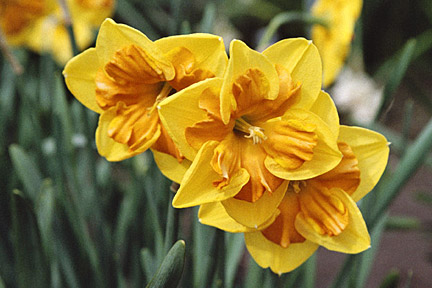 Division 11a – Split-corona (Collar): These have a cup that is split into segments, usually two whorls of three segments, giving the flowers an orchid-like appearance. e.g. Narcissus ‘Menehay’
Division 11a – Split-corona (Collar): These have a cup that is split into segments, usually two whorls of three segments, giving the flowers an orchid-like appearance. e.g. Narcissus ‘Menehay’ 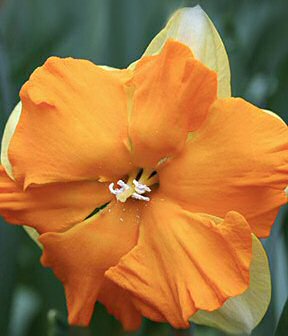 Division 11b – Split-corona (Papillon): These have a cup split into one whorl of six segments, resulting in a flatter, more open face than the collar types. e.g. Narcissus ‘Centannees’
Division 11b – Split-corona (Papillon): These have a cup split into one whorl of six segments, resulting in a flatter, more open face than the collar types. e.g. Narcissus ‘Centannees’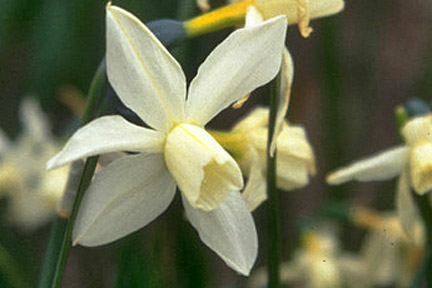 Division 12 – Miscellaneous: These are daffodils that do not fit into any other division. e.g. Narcissus ‘Toto’
Division 12 – Miscellaneous: These are daffodils that do not fit into any other division. e.g. Narcissus ‘Toto’ 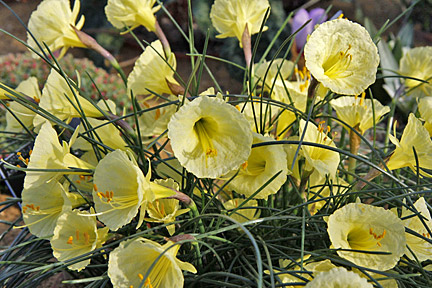 Division 13 – Species daffodils (including wild narcissi): Some of the small species grow well in pots and rock gardens. e.g. Narcissus romieuxii
Division 13 – Species daffodils (including wild narcissi): Some of the small species grow well in pots and rock gardens. e.g. Narcissus romieuxiiNotes
Intermediate and miniature
Intermediate daffodils: between 51mm and 80mm in diameter
Miniature daffodils: up to 50mm in diameter
Perianth and corona colour
Where a class requires blooms to have a yellow-orange or white perianth or corona, the perianth or corona must be predominantly, but not necessarily exclusively, that colour.
Rim
Rimmed daffodils are those which display at the corona rim a clearly defined band of colour that is different from the colour or colours of the corona base and mid-zone.
